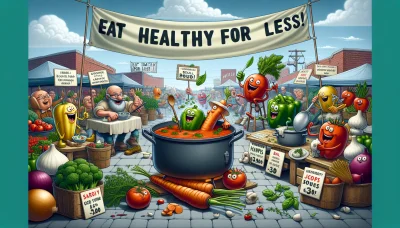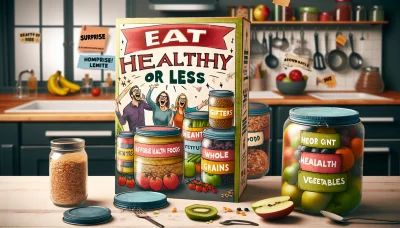Spring Vegetable Casserole Quiz
Test Your Knowledge
Question of
Spring Vegetable Casserole: A Fresh Take on Healthy Eating
Incorporating fresh, seasonal vegetables into our diets is crucial for optimal health. Seasonal vegetables are at their peak in flavor and nutritional value, offering a range of vitamins, minerals, and antioxidants that support overall well-being. A diet rich in vegetables can improve heart health, aid in weight management, and reduce the risk of chronic diseases. Embracing a variety of seasonal vegetables not only enhances the taste of our meals but also contributes to a more sustainable and environmentally friendly food system. By choosing to eat seasonally, we support local farmers, reduce our carbon footprint, and enjoy the freshest produce available.
What Makes Spring Vegetables Special?
Spring vegetables are a vibrant and vital part of a balanced diet, heralding the arrival of warmer weather with their fresh flavors and bright colors. These seasonal gems, including asparagus, spinach, peas, and radishes, offer a plethora of nutritional benefits that are essential for maintaining good health. Rich in vitamins, minerals, and antioxidants, spring vegetables support a healthy immune system, promote heart health, and can contribute to maintaining a healthy weight. Their high fiber content aids in digestion and helps in feeling fuller for longer, making them an excellent choice for anyone looking to incorporate more healthful foods into their diet. Including a variety of these vegetables in your meals not only adds a burst of flavor but also ensures that you're getting a wide range of nutrients essential for a well-rounded diet.
The Key Ingredients for Your Spring Vegetable Casserole
- Asparagus, trimmed and cut into pieces
- Carrots, peeled and sliced
- Green beans, trimmed
- Leeks, cleaned and sliced
- Peas, fresh or frozen
- Zucchini, sliced
- Yellow squash, sliced
- Broccoli florets
- Cauliflower florets
- Garlic, minced
- Fresh thyme
- Olive oil
- Salt and pepper to taste
- Grated cheese (optional)
- Breadcrumbs (optional for topping)
Step-by-Step Guide to Making Your Spring Vegetable Casserole
- Gather Your Ingredients: Collect 2 cups of sliced zucchini, 2 cups of sliced yellow squash, 1 cup of chopped asparagus, 1 cup of diced bell peppers, 1 diced onion, 3 minced garlic cloves, 1 cup of shredded cheese (your choice), 1 cup of milk, 2 eggs, 1/2 cup of flour, salt, pepper, and olive oil.
- Preheat Your Oven: Preheat your oven to 375°F (190°C) to ensure it's ready for baking.
- Prepare the Vegetables: In a large skillet over medium heat, add a splash of olive oil and sauté the onion and garlic until translucent. Gradually add the zucchini, yellow squash, asparagus, and bell peppers, cooking until just tender. Season with salt and pepper to taste.
- Mix the Batter: In a separate bowl, whisk together the milk, eggs, and flour until smooth. This mixture will help bind the casserole.
- Combine and Assemble: In a large mixing bowl, combine the sautéed vegetables with the batter. Mix well to ensure all the vegetables are coated. Then, transfer the mixture into a greased baking dish.
- Add Cheese: Sprinkle the shredded cheese evenly over the top of the vegetable mixture. This will create a delicious, golden crust as it bakes.
- Bake the Casserole: Place the baking dish in the preheated oven and bake for 35-45 minutes, or until the casserole is set and the cheese is golden brown.
- Let it Rest: After baking, remove the casserole from the oven and let it sit for about 5 minutes. This allows it to firm up, making it easier to slice.
- Serve and Enjoy: Cut the casserole into squares or slices and serve warm. It's a perfect dish for a spring brunch or a light dinner.
Preparation Time: 20 minutes
Cooking Time: 45 minutes
Customizing Your Casserole: Tips and Variations
Transforming your basic spring vegetable casserole into a dish that perfectly suits your taste preferences or dietary requirements is easier than you might think. For those looking to add a bit more protein, consider incorporating chunks of grilled chicken or tofu. If you're aiming for a low-carb option, substitute starchy vegetables with a mix of cauliflower and broccoli. Dairy-free? No problem! There are plenty of plant-based cheese alternatives that melt beautifully for that golden, bubbly top. And for an extra burst of flavor, don't hesitate to mix in your favorite herbs or a sprinkle of chili flakes for some heat. The beauty of casseroles lies in their versatility, so feel free to experiment and make the dish your own.
Pairing Your Casserole: Serving Suggestions
Enhancing the flavors of a spring vegetable casserole requires thoughtful pairing with the right side dishes and drinks. A fresh garden salad, dressed lightly with vinaigrette, adds a crisp, refreshing contrast to the casserole's richness. For a heartier companion, consider a loaf of artisan bread, perfect for soaking up the flavorful sauce. When it comes to drinks, a light, citrusy white wine or a sparkling water with a squeeze of lemon complements the casserole's vibrant flavors without overwhelming them. These pairings not only balance the meal but also elevate the dining experience, making every bite of the casserole more enjoyable.
Preserving the Freshness: Storage Tips for Leftovers
To ensure your spring vegetable casserole remains as delightful as when it was first served, proper storage is key. Begin by allowing the casserole to cool to room temperature, but do not leave it out for more than two hours to avoid bacterial growth. Transfer the casserole into airtight containers, preferably glass for better preservation of flavor and to avoid staining. If you have a large quantity, consider dividing it into smaller portions. This not only helps the casserole cool down more quickly but also makes for easier reheating of individual servings. Seal the containers tightly and label them with the date. Your casserole can be stored in the refrigerator for up to 3-4 days. For longer storage, freeze it, ensuring it's tightly wrapped or in a sealed container to prevent freezer burn. When you're ready to enjoy your casserole again, reheat it thoroughly to an internal temperature of 165°F to ensure safety and restore its delightful taste and texture.












